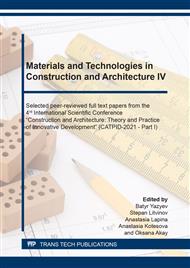p.61
p.67
p.73
p.81
p.93
p.101
p.109
p.115
p.121
Investigation of the Synthesized Calcium Hydrosilicates Effect on the Properties of Energy-Saving Wall Silicate Blocks Obtained on the Basis of Technogenic Raw Materials
Abstract:
Currently, building blocks are widely used in the construction industry, the use of which contributes to an increase in the speed of construction several times, and also reduces labor costs. To obtain wall blocks, various binders are currently used, but the use of composite binders obtained on the basis of new types of raw materials, is relevant. Among the currently non-used natural raw materials, it is possible to single out aluminosilicate rocks, unconventional for the construction industry, characterized by the presence of clay rocks of mineral formation unfinished stage (aggregates) in their composition. Based on the results of the studies carried out, the effect of the synthesized calcium hydrosilicates addition was established as СSH (I) and С2SH(A) on the properties of energy-saving wall silicate blocks obtained on the basis of technogenic aluminosilicate raw materials. The rational content of the СSH (I) additive is 1.5 wt. %, which contributes to an increase in the products’ strength by 30-50%. The optimum lime content in the raw mix is 12 wt. %. The nature of the influence С2SH(A) on the properties of non-autoclave silicate materials obtained by the method of injection technology, in general, coincides with the addition of CSH (I). The resulting material can be used as a structural material (non-supporting structures) inside low-rise buildings and structures. Low average density of this material (1300–1450 kg/m3) indicates the best thermal properties (the thermal conductivity coefficient of the samples is 0.17 W/m·K).
Info:
Periodical:
Pages:
93-99
Citation:
Online since:
August 2021
Price:
Сopyright:
© 2021 Trans Tech Publications Ltd. All Rights Reserved
Share:
Citation:


